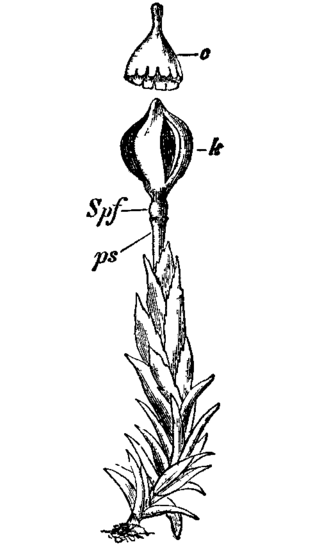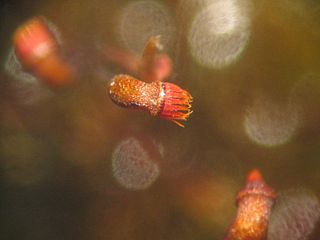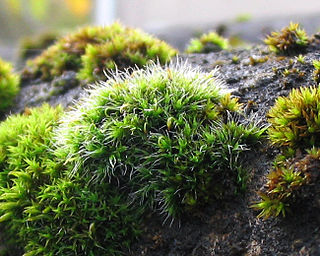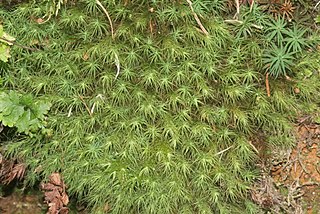| Bryales | |
|---|---|
 | |
| Bryum capillare | |
| Scientific classification | |
| Kingdom: | Plantae |
| Division: | Bryophyta |
| Class: | Bryopsida |
| Subclass: | Bryidae |
| Superorder: | Bryanae |
| Order: | Bryales Limpr. |
| Families | |
Bryaceae | |
| Bryales | |
|---|---|
 | |
| Bryum capillare | |
| Scientific classification | |
| Kingdom: | Plantae |
| Division: | Bryophyta |
| Class: | Bryopsida |
| Subclass: | Bryidae |
| Superorder: | Bryanae |
| Order: | Bryales Limpr. |
| Families | |
Bryaceae | |
The order Bryales includes the following five families: [1] [2]
The order used to be defined broadly to include the Rhizogoniales, but is now used in a narrower sense. [3] A species of the Mniaceae genus Rhizomnium , Rhizomnium dentatum , was described from fossil gametophytes preserved in Baltic amber. [4]
The families Catoscopiaceae and Pseudoditrichaceae were previously placed in Bryales, but are now placed in Dicranidae as part of an early branching grade. [2] [5]

Andreaeaceae is a family of mosses which includes two genera, Andreaea, containing about 100 species, and the genus Acroschisma. The Andreaeaceae prefer rocky habitats ranging from tropical to arctic climates, on which they form tufted colonies, typically with reddish to blackish shoots. The capsules lack the peristome mechanism and dehisce longitudinally to release the spores, resulting in a paper-lantern appearance.

The Bryopsida constitute the largest class of mosses, containing 95% of all moss species. It consists of approximately 11,500 species, common throughout the whole world.

Bryidae is an important subclass of Bryopsida. It is common throughout the whole world. Members have a double peristome with alternating tooth segments.

Orthotrichaceae is the only family of mosses in the order Orthotrichales. Many species in the family are epiphytic.

Funariales is an order containing 356 species,26 genera and 7 families.

Grimmiales is an order of mosses in the subclass Dicranidae. It comprises four families: Grimmiaceae, Ptychomitriaceae, Seligeriaceae, and Saelaniaceae.
Andreaeobryum is a genus of moss with a single species Andreaeobryum macrosporum, endemic to Alaska and western Canada. The genus is placed as a separate family, order and class among the mosses.
Gigaspermaceae are a family of mosses in the monotypic order Gigaspermales. The order is placed in subclass Gigaspermidae of the class Bryopsida. They were previously placed in subclass Funariidae.

Encalyptales is an order of mosses in subclass Funariidae. It contains a single family.

Timmia is a genus of moss. It is the only genus in the family Timmiaceae and order Timmiales. The genus is named in honor of the 18th-century German botanist Joachim Christian Timm.

Dicranales is an order of haplolepideous mosses in the subclass Dicranidae.

Fissidentaceae is a family of haplolepideous mosses (Dicranidae) in the order Dicranales, with a single genus, Fissidens. It was formerly placed in the now-obsolete order Fissidentales.

Bryaceae is a family of mosses.

Bartramiales is an order of moss.
Pseudoditrichales is an order of haplolepideous mosses in the subclass Dicranidae. It comprises two families, Pseudoditrichaceae and Chrysoblastellaceae. Pseudoditrichaceae was previously placed in Bryales, while Chrysoblastellaceae is a new family erected for Chrysoblastella, which was previously placed in Ditrichaceae.
Calymperaceae is a family of haplolepideous mosses (Dicranidae) in the order Dicranales.

Distichium is a genus of haplolepideous mosses (Dicranidae) in the monotypic family Distichiaceae.
Timmiellaceae is a family of haplolepideous mosses (Dicranidae). It contains two genera, Luisierella and Timmiella, that were formerly place in family Pottiaceae.
Catoscopium is a genus of haplolepidous mosses (Dicranidae) in the monotypic family Catoscopiaceae .
Saelania is a genus of mosses in the monotypic family Saelaniaceae in subclass Dicranidae. The genus was previously placed in family Ditrichaceae. Saelania is named after Finnish botanist Thiodolf Saelan.